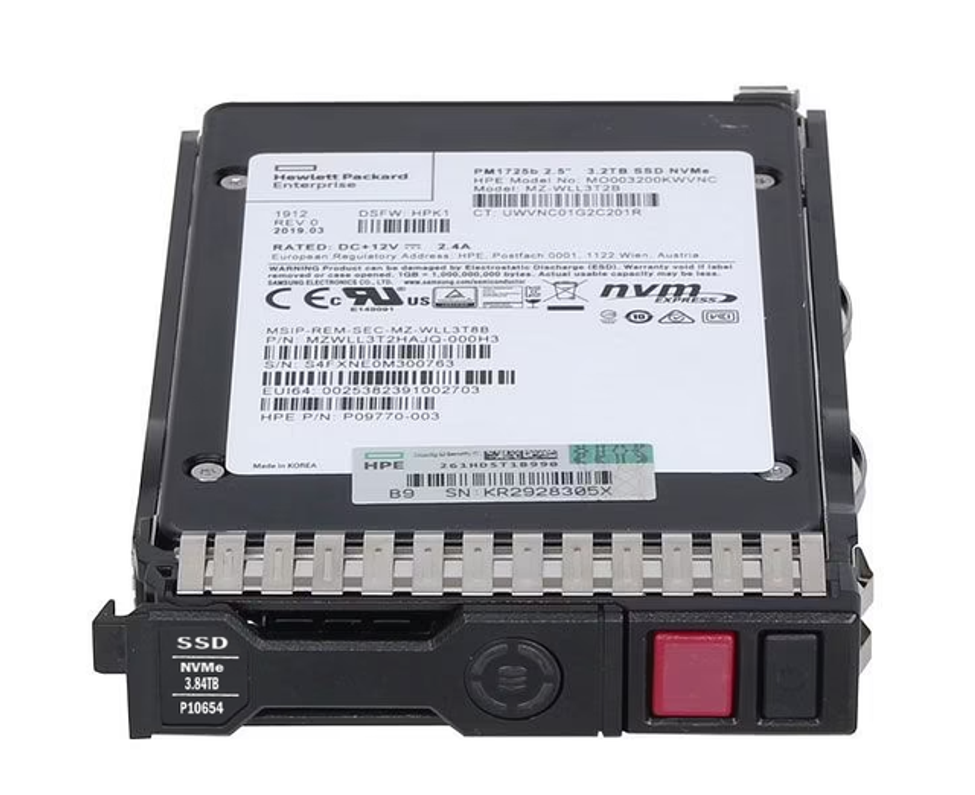Understanding HPE NVMe PCIe SCN Read Intensive SSD for ProLiant Gen9 and Gen10 Servers
Hewlett Packard Enterprise (HPE) is a leading provider of enterprise-grade server, storage, and networking solutions. Among its portfolio of high-performance storage solutions is the HPE NVMe PCIe SCN Read Intensive SSD series, designed specifically for HPE ProLiant Gen9 and Gen10 servers. These drives offer businesses a cost-effective, high-speed storage option optimized for read-intensive applications, providing substantial improvements in data access and operational efficiency.
Key Features of HPE NVMe PCIe SCN Read Intensive SSDs
1. Non-Volatile Memory Express (NVMe) Interface :
NVMe is a storage protocol designed specifically for flash memory, delivering significantly faster speeds compared to traditional SATA-based SSDs. By utilizing the PCIe (Peripheral Component Interconnect Express) bus, NVMe drives minimize latency and maximize bandwidth, making them ideal for high-performance computing tasks and workloads that require fast data access.
2. Read Intensive Performance :
As the name suggests, HPE NVMe PCIe SCN Read Intensive SSDs are optimized for applications where read operations dominate, such as data analytics, content delivery, virtualized environments, and web servers. These drives prioritize quick data retrieval, offering high Input/Output Operations Per Second (IOPS) and low latency for read-heavy tasks.
3. Compatibility with ProLiant Gen9 and Gen10 Servers :
HPE ProLiant servers are widely recognized for their scalability and enterprise reliability. The NVMe PCIe SCN Read Intensive SSDs are fully compatible with both Gen9 and Gen10 ProLiant models, enabling businesses to easily integrate high-speed storage solutions without requiring significant infrastructure changes. The Gen10 series also supports additional optimizations in security and performance, which can be further enhanced by these SSDs.
4. Cost Efficiency :
Read-intensive SSDs are designed to provide the best performance for environments with relatively lower write activity, which extends the drive's lifespan. This characteristic makes them a cost-effective solution for companies that require high-performance storage without the need for high endurance. Since the majority of enterprise applications involve more reads than writes, these SSDs strike a balance between performance and affordability.
5. Improved Data Center Efficiency :
These NVMe SSDs consume less power and generate less heat compared to traditional spinning hard disk drives (HDDs). By deploying them in ProLiant servers, businesses can reduce their overall power consumption, cooling requirements, and space constraints in data centers. This contributes to lower operational costs and a more sustainable IT infrastructure.
6. Enhanced Reliability :
HPE SSDs undergo rigorous testing and validation processes to ensure compatibility, performance, and reliability. The HPE NVMe PCIe SCN Read Intensive SSD series offers robust error correction, end-to-end data protection, and power-loss protection, all of which are critical for maintaining data integrity and minimizing the risk of data loss.
7. Scalability :
As businesses grow, their storage needs evolve. HPE’s NVMe PCIe SCN Read Intensive SSDs offer scalability options that allow enterprises to expand their storage capacity seamlessly. Whether you are upgrading existing infrastructure or planning for future growth, these SSDs offer a path to handle increasing data volumes without sacrificing performance.
Use Cases for HPE NVMe PCIe SCN Read Intensive SSDs
1. Big Data and Analytics :
For enterprises engaged in big data analytics, the ability to quickly access and analyze massive datasets is crucial. The NVMe Read Intensive SSDs enable rapid data retrieval, allowing businesses to process information in real time and gain actionable insights faster.
2. Virtualized Environments :
In virtualized environments, the performance of storage drives directly impacts the speed and efficiency of virtual machines (VMs). By deploying HPE NVMe PCIe SCN Read Intensive SSDs, businesses can reduce latency and boost IOPS, ensuring that VMs perform optimally even under heavy workloads.
3. Web and Cloud Applications :
Web servers, cloud platforms, and content delivery networks rely heavily on fast, consistent read operations. These SSDs offer the low-latency, high-speed data access required to deliver smooth user experiences and improve the performance of hosted services.
4. High-Performance Computing (HPC) :
HPC workloads, such as scientific simulations, financial modeling, and machine learning, require vast amounts of data to be processed quickly. NVMe Read Intensive SSDs provide the high throughput necessary to accelerate computation times and reduce bottlenecks in data processing.
Benefits of Using HPE NVMe PCIe SCN SSDs in ProLiant Servers
- Increased Performance :
NVMe SSDs significantly boost server performance, enabling faster data access and reducing overall latency.
- Scalability :
These SSDs are ideal for businesses that need to scale their storage solutions while maintaining high performance and reliability
- Cost-Effectiveness :
Designed for read-intensive applications, these drives offer excellent performance at a lower cost than write-intensive alternatives, providing a cost-effective solution for many enterprise applications.
- Energy Efficiency :
Reduced power consumption and heat output translate into lower operational costs for data centers.
- Seamless Integration :
Fully compatible with HPE ProLiant Gen9 and Gen10 servers, these SSDs are easy to deploy and manage within existing infrastructures.
Conclusion
The HPE NVMe PCIe SCN Read Intensive SSD series for ProLiant Gen9 and Gen10 servers is a powerful storage solution tailored for enterprises with read-heavy workloads. Offering high performance, reliability, and cost efficiency, these drives help businesses enhance their data processing capabilities, streamline operations, and reduce total cost of ownership. By leveraging the advanced technology of NVMe and PCIe, organizations can improve their IT infrastructure's responsiveness, scalability, and efficiency—positioning themselves for success in a data-driven world.
Recent Posts
-
Accelerate Your Enterprise: Unleashing the Power of the HPE 300GB 15K RPM SAS-12Gbps Smart Drive
In today's enterprise IT environments, the demand for high-performance, reliable, and secure storage …Jan 28th 2025 -
Accelerate Enterprise Performance: Exploring the HPE 900GB 10K RPM SAS-12Gbps Hard Drive for ProLiant Servers
In the realm of enterprise computing, choosing the right storage solutions is critical for achieving …Jan 27th 2025 -
Secure and Reliable Storage: HPE 1TB 7200RPM SAS-12Gbps SFF Hard Drive for ProLiant Servers
The HPE 1TB 7200RPM 2.5-inch Small Form Factor (SFF) Digitally Signed Firmware Hard Drive is a robus …Jan 22nd 2025




